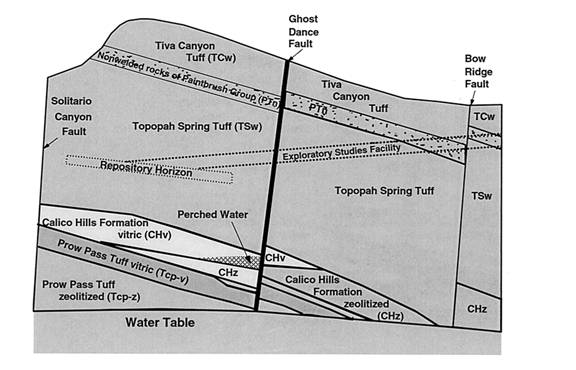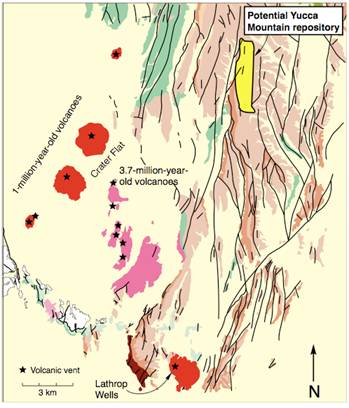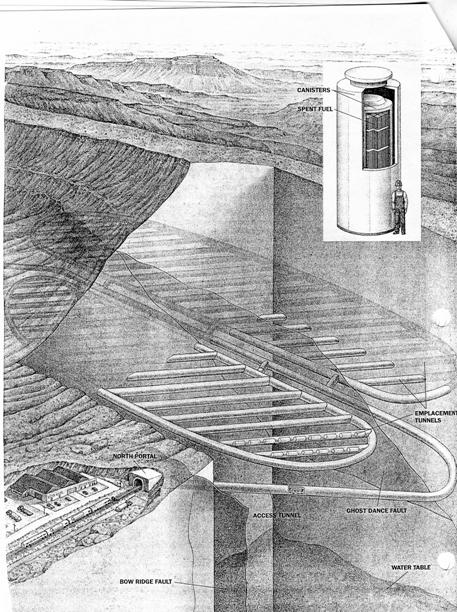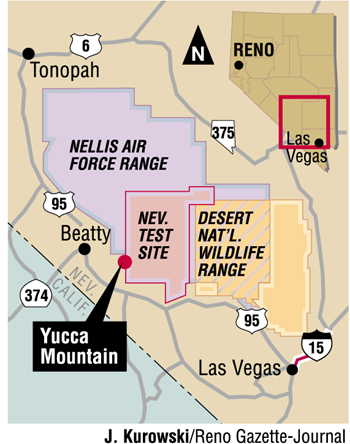Geology and Natural Heritage of the Long Valley Caldera
Summary of Geologic and Political Conditions of Yucca Mountain, Nevada
Carrie Schedler
Abstract
The proposed nuclear waste repository at Yucca Mountain , located in southern Nevada , has been a hotbed of controversy ever since its selection as the repository site in 1987. In the two decades since its selection, a fierce geological and political battle over the advantages and disadvantages of the site itself has been waged, making any progress at the site impossible. This paper aims to illuminate the sources of the stalemate and the mutual impacts of science and politics illustrated in this conflict by focusing on the pros and the cons of the site itself.
Introduction
As the nuclear power industry and the testing of nuclear weapons grew in the later part of the 20th century, the United States Congress recognized the need to begin to plan for a long-term storage solution for potentially hazardous nuclear waste, which was and still is kept in above-ground storage facilities throughout the country. The passage of the Nuclear Waste Policy Act in 1982 began the process of considering several possible sites for nuclear waste storage; Yucca Mountain was a natural choice for this process as it had been researched as a possible waste repository beginning in 1978. After narrowing an initial list of ten possible sites down to three, Yucca Mountain was selected as the final site in 1987, and research has continued at the site since then. In July 2002, President George W. Bush signed House Resolution 87, allowing the US Department of Energy
to petition the Nuclear Regulatory Commission for permission to begin construction at the site in order to meet a proposed opening date in 2010. However, fierce opposition from the state of Nevada and its citizens has slowed the process, along with several remaining geological concerns.
Geologic Background
Yucca Mountain is less of a traditional mountain and more like a ridge. It is approximately 29 meters long and is made up mostly of volcanic tuff, most of which is classified as the Topopah Springs Tuff, that is estimated to be between 11 and 13 million years old. However, younger unwelded rocks and Tiva Canyon tuff appear as strata above this large tuffaceous layer (fig. 1). Within the mountain are two large normal faults, the Ghost Dance Fault and the Bow Ridge Fault. The proposed repository site, which is burrowed into the Topopah Springs Tuff and cuts through the two faults, is about 300 meters below the mountain's surface and 240 to 370 meters above the water table (Whipple, 74). It is in the Basin and Range province and sits near the Death Valley region, and Death Valley itself is the main water discharge area for the mountain.
The area around the site is studded with volcanic vents, ranging from 4 million years in age to 75,000 years. Twelve volcanoes are within 20 km of the site and all of them produced basaltic eruptions (figure 2). Eruptions have been anywhere from effusive to strombolian in explosivity. The cinder cone at Lathrop Wells, which is the youngest volcano in the region, shows distinct evidence of effusivity, with lava flows, and of explosivity, with lots of fragmented and vesicular rocks (Perry, 492).
Figure 1. A cross-section of the rock layers in Yucca Mountain (Flint, 451).
Figure 2. Map of volcanoes nearest to repository site and their relative ages (Perry, 492).
The Yucca Mountain Nuclear Waste Repository Design
The design of the Yucca Mountain repository, partially shown in Figure 3, would consist of a u-shaped access loop into the heart of the repository, with canisters of spent fuel placed horizontally in troughs inside the mountain. Two large sets of tunnels would be constructed to store the barrels of waste, which would all be kept inside multilayered barrels made of steel and titanium alloys. An automated system would send the barrels to the tunnels after being repackaged. The site would have the capacity to hold 70,000 metric tons of both high-level nuclear waste and spent radioactive fuel. Most of the waste would come from nuclear power plants, while a smaller percentage would come from defense waste. The allocation for commercial waste is enough space for most of the nuclear waste from power plants in the US, barring the construction of any new facilities, for the next 40 years. However, the allocation for defense wastes is not even sufficient for all of the waste currently in existence (Whipple, 74-5. ) After the repository is filled, it would be monitored for 50 years before being completely sealed off.
Figure 3. Representation of the interior of proposed repository (Whipple, 75).
Risks of Nuclear Exposure
The biggest and most uncertain risk factor at the Yucca Mountain site, should construction be completed and the site sealed off, is the leakage of nuclear fuels out of their containers and, consequently, into the groundwater. Should this happen, any human exposure to contaminated water could cause illness, death and harm to to the environment. How could this happen? First, the containers that the waste is stored in would have to corrode. The repository exists in an unsaturated environment, which means that the rock is above the water table. However, unsaturated rock environments promote oxidation, which speeds the corrosion process in metals. The saturation of the rock proves to be a tricky obstacle, as the repository cannot be too close to the water table yet needs some saturation to prevent corrosion. Chris Whipple's article “Can Nuclear Waste Be Stored
Safely at Yucca Mountain?” from the June 1996 issue of Scientific American cites several possible container corrosion scenarios, ranging from a continuous drip of a single water droplet onto a canister to a change in humidity in the site. He notes that to offset the corrosion caused by humidity, the site would have to be kept at extreme heat temperatures, which would in turn cause its own type of corrosion. Even safety analyses predict that the most likely cause of the degradation of the Yucca Mountain site is the failure of the waste containers. As of yet, no “safe” material combination has been determined.
So, should the containers fail, as they most certainly will, the next issue of contention is water itself. Since Yucca Mountain only gets about 16 cm of precipitation each year, the minimal amount of water relies very heavily on the rocks of the mountain for its movement patterns. There are two major unknowns within this: first, the rate of infiltration (how quickly the water moves through the rock) and second, the method of infiltration. Rainfall varies seasonally, and along with it varies infiltration rates, with winter being the season most conducive to infiltration. So, as water infiltrates the mountain, the next most important factor is how exactly it moves through the rock. There are two possibilities: one, the water moves through fractures in the rock, or two, the water moves through the rock itself. If the water moves through rock fractures, the threat to the water table increases as the water moves with very few inhibitors, including zeoliths that might absorb some of the harmful radionuclides that the water might absorb by passing through the storage area. However, if the water moves through the rock itself, this would greatly slow the rate of infiltration and the direct threat to the water table. Even if the water comes in contact with radionuclides from the nuclear waste, the passage through rock might remove some of the radionuclides or at least slow their passage to the water table. Since Yucca Mountain is so large and made up of several strata of rock, it is almost impossible to classify the type of infiltration in all of the mountain and is likely variable throughout.
The next factor to consider is human activity, both present and future. Whipple notes that it is almost impossible to characterize human settlement patterns in the future and inadvertent nuclear exposure could very well be a threat to future generations. No plan yet exists on how to prevent this for future possible inhabitants. Also, the site is not far from Las Vegas, and, should any sort of disturbance occur at the site, Las Vegas could theoretically be at risk.
Figure 4. General location of Yucca Mountain in relation to developed areas (NV Seism. Library).
The site could also prove to be a national security threat, as a highly-publicized nuclear waste repository that could possibly come into contact with groundwater, causing widespread radiation poisoning might be a tempting prospect for a group looking to harm US residents. Recently, the US House of Representatives has called for several hearings to discuss the “mismanagement and the problems that flow from it.... [including] quality assurance” (Broken, 4) at Yucca Mountain. The Committee on Government Reform has cited on several occasions lax standards of quality assurance and bureaucratic mismanagement that have already threatened the state of the project, with the added threat of poor standards down the road. This particular hearing noted that quality assurance tools put in place by the Department of Energy did not address any of the known problems or threats at the mountain, despite Department of Energy assurances that the standards would be reassessed, noting that these findings represented real concerns that the project was being poorly handled and was not being carried out with safety as the first priority (Broken, 5).
Other possible disturbances, namely volcanism and earthquakes, present a lesser threat. The probability of a volcanic eruption, despite the nearness of several volcanic threats, was calculated by a team of Los Alamos researchers to be 10-8 events per year, which is exactly the Nuclear Regulatory Commission's cutoff level for volcanism to no longer be considered a threat (Perry, 492). However, other estimates have found the probability to be both greater (slightly more than 10-7 ) and much, much less (almost10-11. ) Though a volcanic event could be incredibly destructive to the site, it is very unlikely and should not be considered as threatening as the possibility of groundwater contamination or human exposure. Additionally, seismic events such as earthquakes, though they are being studied by researchers, tend to be less effective at harming underground structures (Whipple, 77).
Conclusions
The proposed nuclear waste repository at Yucca Mountain, though it represents a necessary next step in the process of nuclear waste storage, is not yet at a stage where it can be deemed scientifically sound enough to begin construction and the acceptance of materials. The uncertainty of groundwater flow, infiltration rates and the possibility of future inadvertent human exposure currently prove too great to justify the benefits of the site's construction. The hasty selection of Yucca Mountain as the repository site, which was done before most research into the site was even begun, shows that little scientific input was registered in the site's selection and therefore may not necessarily be the best option. Additionally, Department of Energy mismanagement hinders the
researching and quailty assurance progress that is necessary for even considering Yucca Mountain as a possible repository site. As of yet, I find very little irrefutably convincing reasoning why Yucca Mountain should be the final site for a nuclear waste repository.
WORKS CITED
Flint, Alan L. , et al. "Hydrology of Yucca Mountain, Nevada. " Reviews of Geophysics 39(2001): 447-470. 5 June 2008.
“Map of Yucca Mountain and Surrounding Area. ” Nevada Seismological Library, 6 June 2008. < http://www. seismo. unr. edu/htdocs/yucca_map. jpg >
Perry, Frank V. , et al. “Analyzing Volcanic Hazards at Yucca Mountain. ” Los Alamos Science 26(2000):492-493.
Whipple, Chris G. “Can Nuclear Waste Be Stored Safely at Yucca Mountain?” Scientific American, June 1996: 72-79.
“Yucca Mountain: Broken Management, Broken Quality Assurance, Broken Project. ” Transcript of US House of Representatives Hearing. 25 April 2006. < http://frwebgate . access . gpo . gov/cgibin/getdoc . cgi?dbname=109_house_hearings&docid=f:32439 . pdf >



